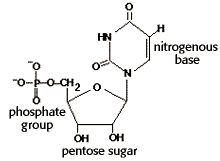1928: Frederick Griffith (transformation)
1947: Erwin Chargaff (series of rules about DNA composition)
- Chargaff's rules
Early 1950s: Watson and Crick discover double helix
- Rosalind Franklin (first X-ray of DNA structure)
9. DNA Structure
DNA Monomer: Nitrogen Bases:
 |
| A=T C≡G |
 |
| 3 bonds: glycosyl, phosphodiester, hydrogen bonds |
8. Replication
Initiation: Helicase, Ssbp, Gyrase
Elongation: Primase, DNA Polymerase III
Termination: DNA Polymerase I, Ligase
7. 5' TATA 3' & AAUAA
Initiation: 5' TATA 3', RNA Polymerase II, Transcription Factors
Elongation: RNA Polymerase II
Termination: AAUAA
6. Pre-mRNA to mRNA
- pre-mRNA: introns (non coding segments)
- spliceosomes: cuts introns and turns them into loops
- includes snRNPs & snRNA
- mRNA: exons (useful code)
5. DNA Translation
- Codons
- Stop codons (UAA, UAG, UGA)
- Always begins with AUG (Met protein)
- tRNA + anticodons + mRNA coding = proteins
- wobble effect (45 types of tRNA instead of expected 61 types)
This is a video that clearly describes the process of translation
4. Mutations
- Point Mutations: change of one base pair of a gene (missense & nonsense)
- Insertions / Deletions: additional or missing nucleotides
- Frameshift Mutation: Leads to the rest of the DNA being messed up
- Mutagens: External causes of mutations (UV light, X-rays, etc).
3. Prokaryotes vs. Eukaryotes
- general differences in their structure and processes
2. Purines and Pyramidines
- Adenine = Thymine
- Cytosine ≡ Guanine
Purine: Adenine + Guanine
Pyramidine: Cytosine + Thymine
1.
5' -> 3'
5' -> 3'
5' -> 3'
5' -> 3'
5' -> 3'
5' -> 3'
5' -> 3'
5' -> 3'
5' -> 3'
5' -> 3'
Get the point?


No comments:
Post a Comment